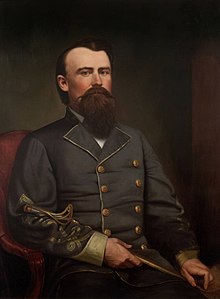| Battle of Little Blue River | |||||||
|---|---|---|---|---|---|---|---|
| Part of the American Civil War | |||||||
 Brigadier General Joseph O. Shelby was a key Confederate commander at Little Blue River | |||||||
| |||||||
| Belligerents | |||||||
|
|
| ||||||
| Commanders and leaders | |||||||
|
Samuel R. Curtis James G. Blunt Thomas Moonlight |
Joseph O. Shelby M. Jeff Thompson Colton Greene | ||||||
| Strength | |||||||
| 2,800 | 5,500 | ||||||
| Casualties and losses | |||||||
| At least 20 | At least 34 | ||||||
The Battle of Little Blue River was fought on October 21, 1864, as part of Price's Raid during the American Civil War. Major General Sterling Price of the Confederate States Army led an army into Missouri in September 1864 with hopes of challenging Union control of the state. During the early stages of the campaign, Price abandoned his plan to capture St. Louis and later his secondary target of Jefferson City. The Confederates then began moving westwards, brushing aside Major General James G. Blunt's Union force in the Second Battle of Lexington on October 19. Two days later, Blunt left part of his command under the authority of Colonel Thomas Moonlight to hold the crossing of the Little Blue River, while the rest of his force fell back to Independence. On the morning of October 21, Confederate troops attacked Moonlight's line, and parts of Brigadier General John B. Clark Jr.'s brigade forced their way across the river. A series of attacks and counterattacks ensued, neither side gaining a significant advantage.
Meanwhile, Blunt had received permission from Major General Samuel R. Curtis to make a stand at the Little Blue River, and he and Curtis returned to the field with reinforcements that brought total Union strength up to about 2,800 men. More Confederate soldiers from the divisions of Brigadier Generals Joseph O. Shelby and John S. Marmaduke arrived on the field, bringing Confederate strength to about 5,500 men. One regiment of Confederate cavalry threatened the Union flank, and Brigadier General M. Jeff Thompson's Confederate brigade pressed the Union center. The Union line fell back and the fighting largely ending around 16:00, when the Union troops reached Independence. The Union soldiers later fell back to the Big Blue River, abandoning Independence.
The next day Union soldiers commanded by Major General Alfred Pleasonton forced their way across the Little Blue River and retook Independence from the Confederates during the Second Battle of Independence. On October 23, the Confederates were defeated by Curtis and Pleasonton at the Battle of Westport, forcing Price's men to retreat from Missouri.
A study published by the American Battlefield Protection Program in 2011 determined that the Little Blue River battlefield was in fragmented condition and was threatened by highway development. It found that part of the site was potentially eligible to be listed on the National Register of Historic Places.
- ^ Kennedy 1998, p. 382.